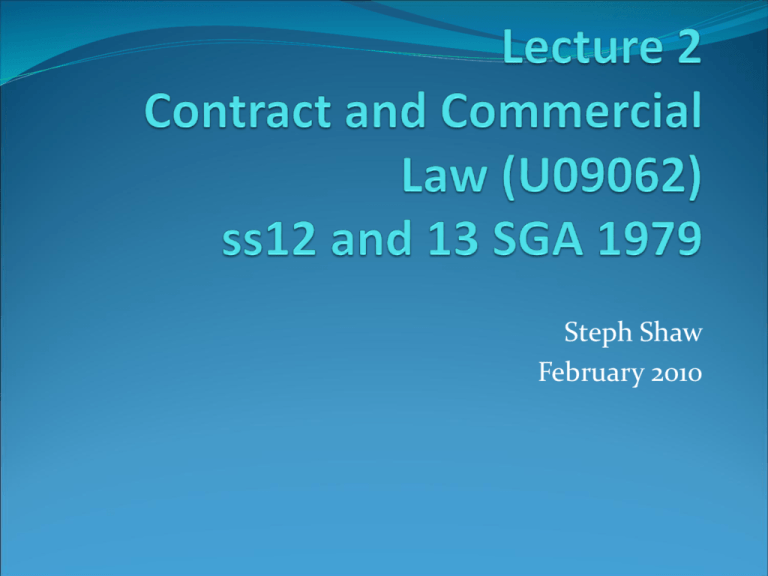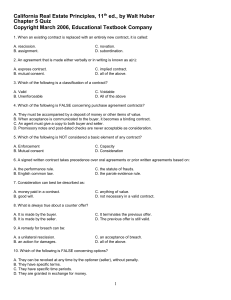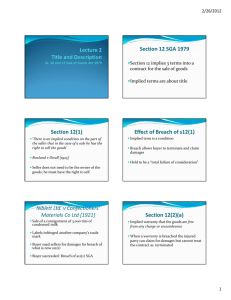Lecture 2 S13 Sale of Goods Act
advertisement

Steph Shaw February 2010 Section 12 SGA The essence of a sales contract is the transfer of property from the seller to the buyer, therefore: Section 12 implies 3 terms into a contract for the sale of goods S12(1) Title ‘There is an implied condition on the part of the seller that in the case of a sale he has the right to sell the goods’ Rowland v Divall [1923]-the defendant had bought in good faith a car which had been stolen. The thief could not pass on good title and neither could the D when he resold it. Where there is a chain of innocent sellers the loser will generally be the person who bought from the thief Seller does not need to be the owner of the goods; he must have the right to sell, i.e. an agent Effect of Breach of s12(1) Implied term in s12(1) is a condition, therefore breach allows the buyer to reject the goods, terminate the contract and sue for damages Held to be a total failure of consideration Niblett Ltd. v Confectioners’ Materials Co Ltd [1921] Sellers agreed to sell a consignment of 3,000 tins of condensed milk. The tins bore a wrapping which infringed another company’s trade mark and that company had the legal right to stop the sale by an injunction. The buyer had to remove the labels and sell the tins at a reduced price. He sued the sellers for damages for breach of what is now s12(1). Although property in the tins had passed to the buyers, never the less they could have been stopped by injunction from selling the tins. Breach of s2(1) SGA S12(2)(a) There is an implied warranty in s12(2)(a) that the goods are free from any encumbrance or charges When a warranty is breached the injured party can claim for damages but cannot treat the contract as terminated S12(2)(b) Implied warranty that the buyer of the goods will enjoy quiet possession of them Microbeads AG v Vinehurst Road Marking Ltd (1975)- breach of s12(2)(b) Rubicon Computer Systems Ltd v United Paints (2000) -breach of s12(2)(b) S12 (contd) These terms cannot be excluded or restricted: s6(1)(a) Unfair Contract Terms Act 1977 s13-Sale by Description s13 provides that where there is a contract for the sale of goods by description there is an implied term that the goods shall correspond to that description If the sale is by sample as well as by description goods must correspond with the sample and description Implied condition applies to all sales regardless of the status of either buyer or seller Caveat Emptor v Caveat Venditor Is basic principle of law ‘buyer beware’ or ‘seller beware’? Historically parties were free to contract on their own terms and were also able to exclude their liability Little legal protection for the buyers of goods Buyers now have a substantial degree of protection against the risk of goods proving to have defects of quality or not being fit for a known purpose Historical Development of s13 SGA By the 1860s courts were prepared to imply terms into contracts for the sale of unascertained goods bought by description where the buyer had not seen the goods, requiring the goods to correspond with the description and be of ‘merchantable’ quality If buyer bought specific goods then he was taken to rely on his own judgment and caveat emptor applied Sale of Goods Act 1893 purported to codify the existing law but important changes were made to the existing law which further eroded the concept of caveat emptor The 1893 Act extended the protection of the implied term relating to sale by description to contracts for the sale of specific goods as well as unascertained goods Until 1973 the Act only required goods to be merchantable where they were sold by description In order to give buyers protection the courts were forced to give ‘sale by description’ an extended meaning Caution!! Some cases on sale by description decided prior to 1973 should be treated with caution What is a sale by description? The description must be a term of the contract and not a representation Statements made during negotiations are classified by the courts as either terms of the contract or representations A representation is not a term of the contract Sale by Description Clearly where the seller sells unascertained goods the sale must be by description Varley v Whipp [1990] Examination of the goods by the buyer does not prevent the sale being a sale by description Grant v Australian Knitting Mills Ltd [1936] Section 13(3) SGA 1979 ‘A sale is not prevented from being by description merely because being exposed for sale the goods are selected by the buyer’. Section 13(3) provides that goods can still be sold by description even if, being exposed for sale they are selected by the buyer. So the fact that a buyer chooses goods, perhaps in a supermarket, for example, will not prevent the goods from having been sold by description. Beale v Taylor [1967]– the goods may describe themselves Use of descriptive words on packaging may be sufficient to make the sale a sale by description Were the goods sold by reference to the description? A sale not necessarily a sale by description merely because descriptive words have been used in negotiations or in the contract Courts now moving away from excessive technicalities-not every statement about quality and fitness of the goods can be treated as part of the description-Ashington Piggeries v Hill s13 concerned with words which identify an essential part of the description of the goods NB s15A SGA a non-consumer buyer cannot reject goods where the breach is so slight that rejection would be unreasonable Reliance There is no liability under s13 if the buyer did not rely on the seller’s description-Harlingdon and Leinster Enterprises v Christopher Hull Fine Art [1991]-described as being a Munter painting Painting was a fake Buyer sought to reject the goods (the painting) on the basis that it did not comply with the description. However: Seller emphasised that he had no expertise and the Buyer had obtained an expert’s opinion, therefore court held: No reliance Nourse L.J. "...the description must be influential in the sale...". ‘The key to s13 is Identification’ The words must identify the kind of goods to be supplied s13 concerned with words which identify ‘an essential part of the description of the goods’ Wallis Son and Wells v Pratt and Haynes [1911] Breach of s13 contract for the sale of English sanfoin seed and instead the seller delivered giant sanfoin If goods are described in detail then goods must correspond to every element Arcos v Ronaasen [1933] A quantity of staves, half inch thick ordered by a buyer Over 95% of the staves delivered were a sixteenth of an inch oversize. Buyer was able to reject Outcome would now probably be different as a result of s15A Ashington Piggeries [1972] S13 construed narrowly Questions of quality are to be dealt with under s14 SGA Contract for the supply of herring meal of ‘fair average quality’ Meal contaminated and proved fatal to the buyer’s mink House of Lords held that the statement was not part of the description for the purposes of s13 and meal was still ‘herring meal’ The contamination did not change its nature! Exclusion of section 13 The seller may seek to exclude or limit liability for breach of the s 13 term however: s13 cannot be excluded where the buyer deals as a consumer-s6(2)(a) UCTA 1977 (B2C)but in other cases (B2B) the exclusion clause must satisfy the reasonableness test-s6(3) UCTA IMPORTANT! Applies to all sales, whether the seller acts in the course of business or privately Breaches of s13 SGA Re Moore & Co and Landauer & Co [1921] Arcos Ltd v E A Ronaasen & Son [1933] Beale v Taylor (1976) Effect of Breach Implied term is a condition therefore breach allows the buyer to reject the goods, terminate the contract and sue for damages s15A SGA means that a business buyer will not be able to reject if breach is slight but instead the buyer must treat the breach of condition as a breach of warranty and therefore claim for damages NB Buyer loses the right to reject if he has accepted them (s35 SGA) Next Week-Lecture 3 Section 14(2) SGA-goods must be of satisfactory quality








